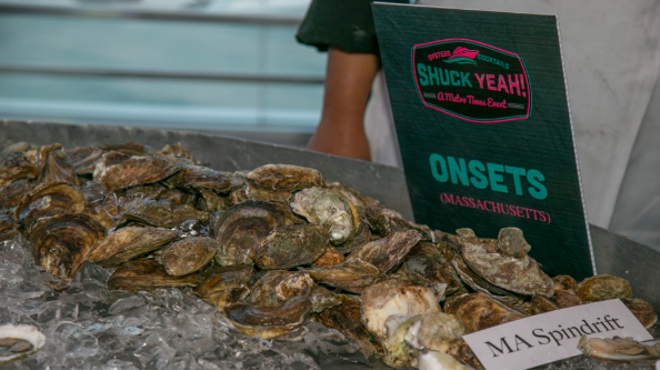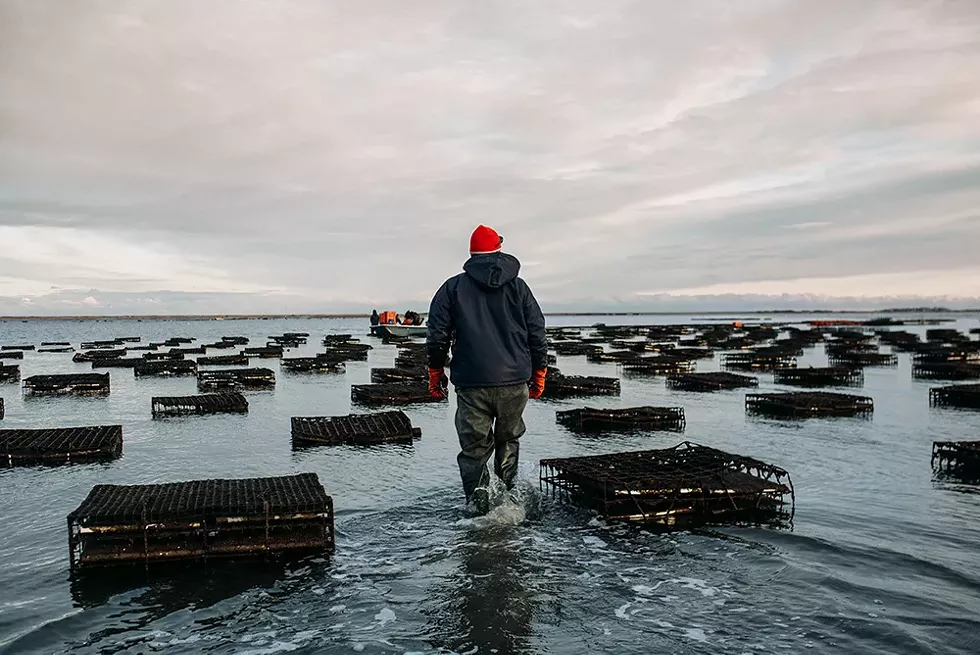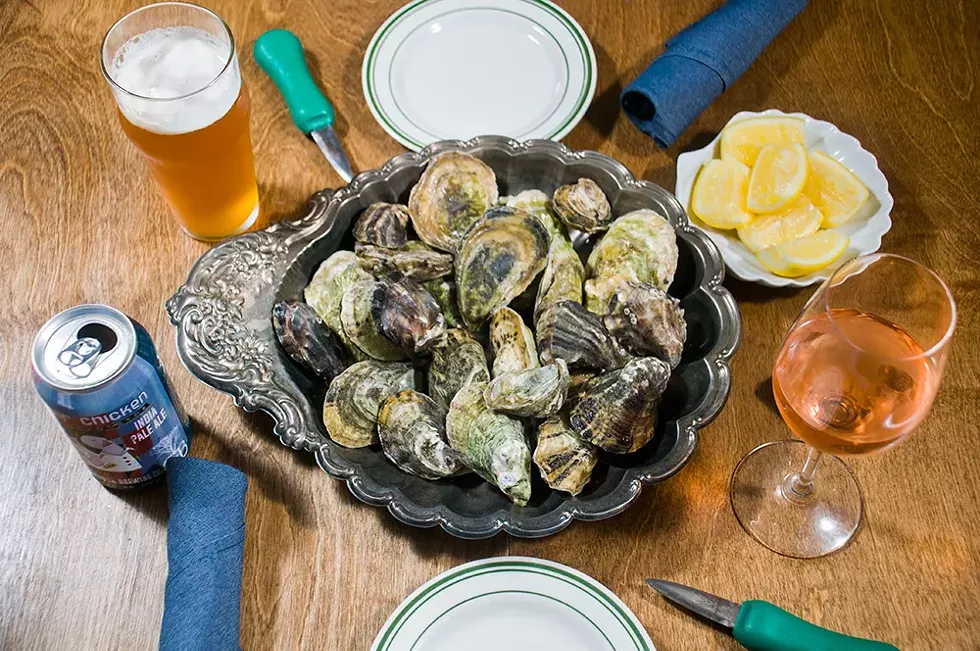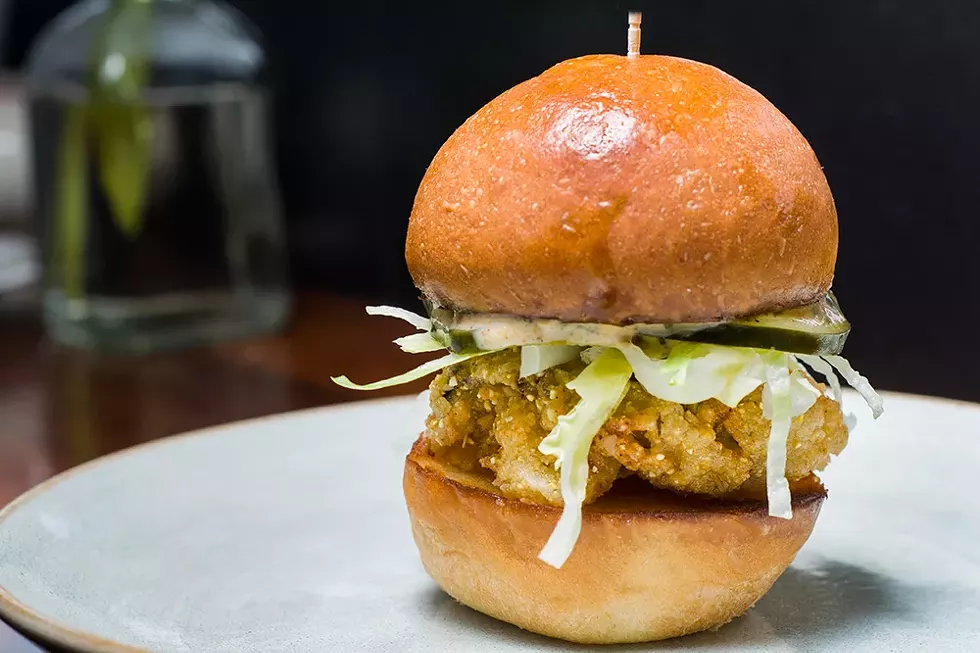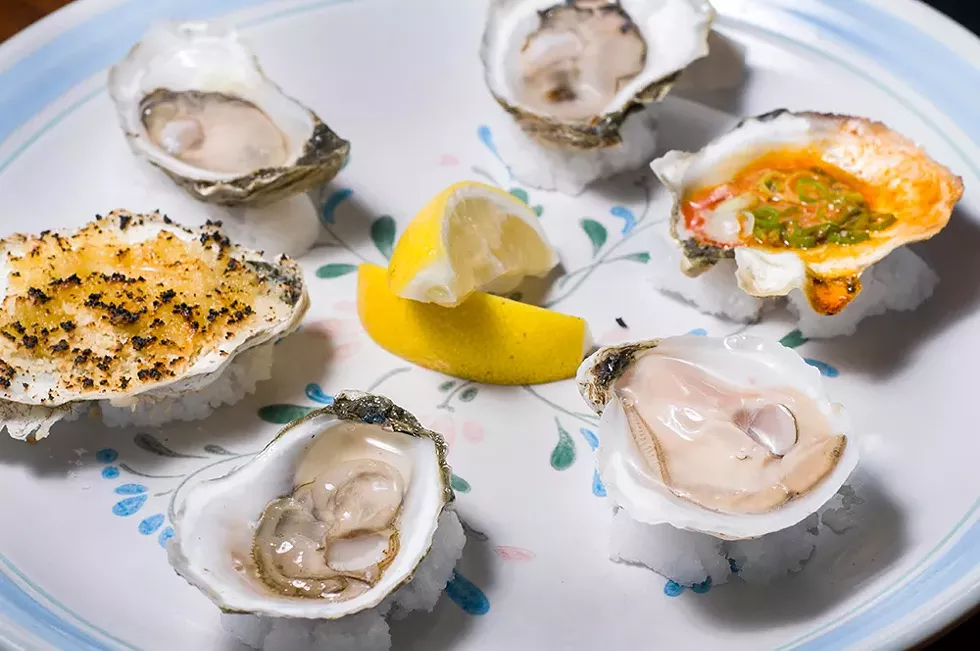The Aunt Dotty is sort of an oyster geek's oyster.
Massachusetts' Island Creek Oysters grows them off a narrow barrier beach that protects the Duxbury Bay — a small body just north of Plymouth that some characterize as the oyster industry's "Napa Valley" — from the much larger Cape Cod Bay and Atlantic Ocean beyond it.
Island Creek founder Skip Bennett lives in an old beach cabin that his family has owned for generations on Saquish Head, a sandy area off the tip of the barrier, and his crew "hand grows" the Dotties, only pulling about 100 bags each week.
Unlike the company's more popular namesake variety, called Island Creeks, the Aunt Dotty isn't so easygoing. Both varieties are complex, holding meaty little nuggets that start off briny, but the Island Creek Oysters' gentle, mossy flavor yields to a buttery, sweet finish.
"A bit like a good wine that blooms in your mouth," says Chris Sherman, the company's president. Meanwhile, the briny Aunt Dotty holds a mineral punch that throws a bit of a curveball that concludes with a somewhat bitter note. It's a fascinating progression.
"The Island Creeks want to be your friend a little more," Sherman says. "The Aunt Dotties are not as fun — they're more like level two of the Island Creeks."
The fact that such immaculate oysters grown on boutique farms are found in and around Detroit is cause for celebration. (Island Creeks are the house oyster at Thomas Keller's French Laundry in Yountville, California, and Per Se in Manhattan, and have been served at White House state dinners.) Hazel Park's Mabel Gray put both varieties front and center at its September Island Creek Oyster Brunch, and in recent months they've been a part of other local restaurants' oyster programs. Their availability is a testament to how far the seafood component of Detroit's restaurant industry is finally moving along.
He was right, and the problem seemed to be a result of several things. Oysters weren't fresh, hadn't been kept at the proper temperature, or were delivered by unscrupulous or lazy seafood distributors that disrespectfully dumped second-rate product on the Detroit market. We deserve some responsibility, too. Customers, chefs, and food writers largely didn't demand better, while some of the city's kitchens sometimes mishandled perfectly good product.
But that's changed dramatically. In 2019, Detroiters eat oysters on the level of those in Portland, Oregon, or Portland, Maine, or anywhere else up and down the coasts. That means the creamy and cucumbery Rock Points from Washington's Puget Sound and briny and buttery Duxbury Bay Island Creeks are clean and pristine, with little lost on their trip from the shore.
The improvement owes to several recent developments in Detroit's food industry. Perhaps most important, the city has better restaurants, chefs, and customers whose expectations far exceed what they did four or five years ago.
"It's more about the people and the city getting a lot more food-focused and a little more ambitious," says Emmele Herrold, a chef at Birmingham's Hazel, Ravines and Downtown. "Just doing something in an average way isn't acceptable anymore if you want to be relevant and compete, especially when you're talking about seafood and shellfish."
A chef is only as good as their producers and suppliers, and partnering with excellent oyster farms and distributors is essential. Motor City Seafood is among the best. The Plymouth, Michigan-based distributor nearly single-handedly made Detroit feel like a seafaring town by becoming the first to fly in sustainably caught seafood from all over the world, pick it up from Detroit Metro Airport multiple times each day, and immediately shuttling it to the area's chefs. Late last year, co-owner Matt Wiseman launched an oyster program.
"It's pretty amazing what we can get now, especially with the sustainability factor with some of the farms that Motor City works with," says Hugh Yaro, owner of Detroit's Craft Work, a restaurant and raw bar that offers around six oysters daily in Detroit's West Village.
"The turnaround times are also way faster," Yaro adds. "We order small batches because we don't want things to be sitting around. At the end of the day, a raw bar and oysters tend to be about freshness."
In 2019, Detroiters eat oysters on the level of those in Portland, Oregon, or Portland, Maine, or anywhere else up and down the coasts.
tweet this
The success of Motor City Seafood's oyster program is partly built around Wiseman's partnership with Island Creek, an oyster farm and distributor that's progressive in terms of sustainability practices and social responsibility. It offers nearly 100 varieties that Motor City imports, and if you're ordering oysters in Detroit with any regularity, then there's a decent chance you've had Island Creek product.
"There's never anything more than two to three days on the tag, which is how many days from when it was harvested, so chefs here have a pristine oyster with all the juices, salinity, and brininess it should have," Wiseman says.
Motor City's customers, like Mabel Gray, Prime and Proper, Craft Work, Lady of the House, Gold Cash Gold, Otus Supply, Sardine Room, London Chop House, Grey Ghost, 220 Townsend, Ocean Prime, Roast, and more are all good places to sample the oysters.
"Other purveyors carry oysters and do a fine job, but Matt's relationship with Island Creek is clutch," says Mabel Gray Chef James Rigato, who recently visited Island Creek to learn about its operation. "Combine that with an increase in public demand and an ever-expanding restaurant scene — voila."
Meanwhile, Hazel, Ravines and Downtown works direct with Island Creek and other small farms and cooperatives, and chefs Jennifer Jackson and Justin Tootla of Ferndale raw bar and restaurant Voyager were perhaps the first in metro Detroit to fly to oyster farms around the country to meet farmers and convince them to ship product here.
They now stock oysters we wouldn't otherwise see, like the Appledore Flats from Damariscotta, Maine. The large oysters are native to France and are grown in a similar environment in Maine along the Damariscotta River. They're slightly briny with a mineral, metallic blast.
At a time when so many restaurants are "buying the same tomatoes, pieces of pork, and fish coming from the same place," visiting small farms gives Voyager a chance to learn about something unique, and the duo's efforts are about "getting the best product that we can," Jackson says.
"We love oysters, oyster farmers, and celebrating the oyster, and to do that the best we can means bringing different farmers to Detroit, and giving them the business that they deserve," Tootla adds. "Meeting these farmers face to face ... and learning their grow methods creates a unique connection."
How nature forms delicious oysters
Prime and Proper oyster program director Caitlin Yost used to work on an oyster farm in Nantucket, and found the oysters in Nantucket Bay on the island's north side and those on the island's south side "tasted wildly different."
As with wines made with grapes that vary depending on the immediate climate in the French wine country, or coffee beans that vary depending on which part of Costa Rica they grew in, subtle nuances exist depending where on the coast oysters formed — even if they're just a few hundred yards apart.
Differences in taste and texture are directly shaped by the micro-climate and habitat in which oysters live. The concept is called "merroir" — the aquatic version of "terroir," which is the term to describe how climate impacts grapes' flavor. Merroir includes things like the water's salinity, temperature, the type of algae the oyster eats, tide strength, direction of currents, mineral content of the sea floor, and even the weather, as heavy rain will wash out an oyster.
The local climate's flavor profile impact is illustrated in the Aunt Dotty and Island Creeks, which are grown about 1.5 miles apart in the Duxbury Bay, but are their own beast because of the different conditions within that short distance.
Sherman explains that the bay's water stays very cold and salty because of how the barrier beach protects it from the Cape Cod Bay, and Duxbury's orientation to the prevailing breeze. The westerly to south-westerly breeze pushes out to sea the bay's surface water, which is replaced with colder, saltier water underneath it. A daily 12-foot tidal swing pulls in a huge volume of water from the Cape Cod Bay, producing strong currents that are also full of high-salinity ocean water.
On a hot summer day, the water temperatures in nearby Wellfleet on Cape Cod can reach the low 90s, but Duxbury water temperatures generally stay in the high 60s. That's a good thing, as colder water arguably creates better oysters. All that has an impact on the algae that oysters consume, which subsequently shapes the oysters' taste.
The Aunt Dotties hang out just behind the Duxbury Bay's barrier beach and are kept in cages that are exposed to the air and prevailing winds for about two to three hours daily. Meanwhile, the Island Creeks are in the middle of the bay, where the tidal shifts don't expose them to the air. There's a big difference in the algae and salinity around each, and the Dotties take about three years to grow, while the Island Creeks are ready for consumption in about 18 months.
"It's pretty crazy," Sherman says. "It may not hit you over the head if you're not paying attention to what you're eating, but you can notice the difference."
Island Creek also grows its own oysters from seeds from its previous season's top oysters. The larvae produced from the seed "is a tiny little thing with only eye that sees only light [and] dark" that marine biologists at the company grow with a steady diet of high-protein algae that lends to good structure.
"In that way, our oysters are our own — they're completely from scratch," says Sean Telo, an Island Creek brand ambassador whose job it is to travel the country eating oysters, drinking Champagne, and talking shop at different food events.
In the kitchens
The city's oyster supplies may be strong, but that isn't the end of the game.
Even though oyster farmers from Maine to the Gulf Shore to the Oregon coast can grow beautiful little oysters that fill up their shells with complex, crisp, clean, briny, sweet, or smoky little nuggets of meat — and distributors can get them to Midwest kitchens in a matter of hours — all that means a lot less if the chef or restaurant screws up the oyster once it lands here.
"You need to be able to clean them, store them, take care of them, [and] shuck them properly, and I think that as oysters become more of a niche, that's something people are taking seriously," Craft Work's Yaro says.
Voyager's Tootla echoes that. He says it's "our responsibility" to do the farmers justice once the oysters arrive, and Voyager takes pains to ensure that its staff is properly trained in the art of shucking.
"We appreciate what the farmers do, so we make sure we're shucking them so the bellies don't burst and it's not mangled," Jackson says.
Tootla adds that there's a clear difference between an oyster prepared by a skilled chef who cares "versus one from a chef who doesn't give a shit."
"We have guests who come to the bar and say that having an oyster that's been properly shucked changes their eating experience," he says.
Approaching an oyster
You can slurp down oysters on Sunday at Shuck Yeah!
Seafood fans, save the date: Shuck Yeah!, Metro Times’ sophomorically named oyster-tasting extravaganza, returns for its third year, this time on Sunday, Oct. 20 at Ferndale’s Otus Supply.
More than 10 different types of oysters will be available for slurping, including Belon, Chesapeake Bay, Copp’s Island, Irish Point, Mirada, Peach Tree, Pink Moon, Sun Hollow, Umami, Wellfleet Wild, and Wild Cat Cove. Pre-sale tickets are $30 and include six oysters, six drink tickets, and two oyster shooters (an oyster floating in a shot). You also get a commemorative shot glass.
There will also be Bloody Marys, cocktails, beer, and food samples from local restaurants like Otus Supply, Beans & Cornbread, Bonefish Grill, Café Muse, Greenspace Café, Spag Burger, Le Petit Dejeuner, Bistro Orleans, and Tom’s Oyster Bar. There will be live music from Phil Nathan of Grateful Dead tribute band Dead Again, who will perform a solo acoustic set, and the KufflinKs.
Shuck Yeah! runs from 11 a.m.-3 p.m. on Sunday, Oct. 20 at Otus Supply, 345 E. Nine Mile Rd., Ferndale; 248-291-6160; otussupply.com. Tickets are $30 advance, $50 at the door. More information is available at mtshuckyeah.com.
Detroit may have good oysters, but it’s a city of oyster novices. How does someone new to the game approach such complex food? Tastes and textures are different from oyster to oyster, and flavor notes shift from the front to back ends of a bite. Some are clean and cucumber-y up front with a mineral finish. Others are firm and smoky. Some are meaty and burst with brine at first, but yield a sweet, buttery finish that sweeps across the taste buds.
The subtle differences can be difficult to decipher at first, but they’re relatively easy to pick up on just by paying close attention, and many restaurants now include short-but-super-helpful descriptions of their oysters’ flavor profiles. The excellent Pangea Shellfish Company, which also operates out of Duxbury Bay and supplies Motor City, even developed a colorful “oyster flavor wheel” that breaks down the different flavors, textures, and finishes.
As a general-but-not-quite-hard-and-fast rule, West Coast oysters are sweeter, while East Coasters are smaller and brinier. Some chefs say it’s better for oyster novices to first sample West Coast oysters because they’re sweeter, while others insist the brininess of the East Coasters makes them more palatable to beginners. Regardless, a good place to start is with a small oyster that won’t pack a mouthful, and Yaros adds that customers shouldn’t be afraid to ask a raw bar chef or server for direction.
“I think it’s just about leaning on servers and chefs a little more and hoping that they’re knowledgeable about the variety that they have in stock and can help steer you to what flavor profile that you might like,” he adds.
Island Creek’s Telo says to avoid some of the common brand names like Blue Points and Malpecs because they’re typically lower quality and so widely used that they can’t be pinned to a specific local region or grower, so one never really knows for sure what they’re getting.
“It’s kind of the difference between Perdue Chicken and a nice pasture-farm bird which is raised on a small and unique farm,” Telo says. Or, for a Detroit-specific analogy, think of the difference between locally made McClure’s pickles versus those made by Vlasic.
Similarly, the popular kumamoto are a sweet West Coast variety, but they’re also one of earth’s five species of oysters and can be grown anywhere between Mexico and Canada in vastly different environments. Though they’ll share some similar traits, the tastes can vary greatly.
Ultimately, there’s a simple rule that’s perhaps the best guiding advice as one starts trying oysters, says Hazel’s Herrod: “Like what you like, and don’t like what you don’t like.”
So many restaurants, so little time. Sign up for our weekly food newsletter delivered every Friday morning for the latest Detroit dining news.


